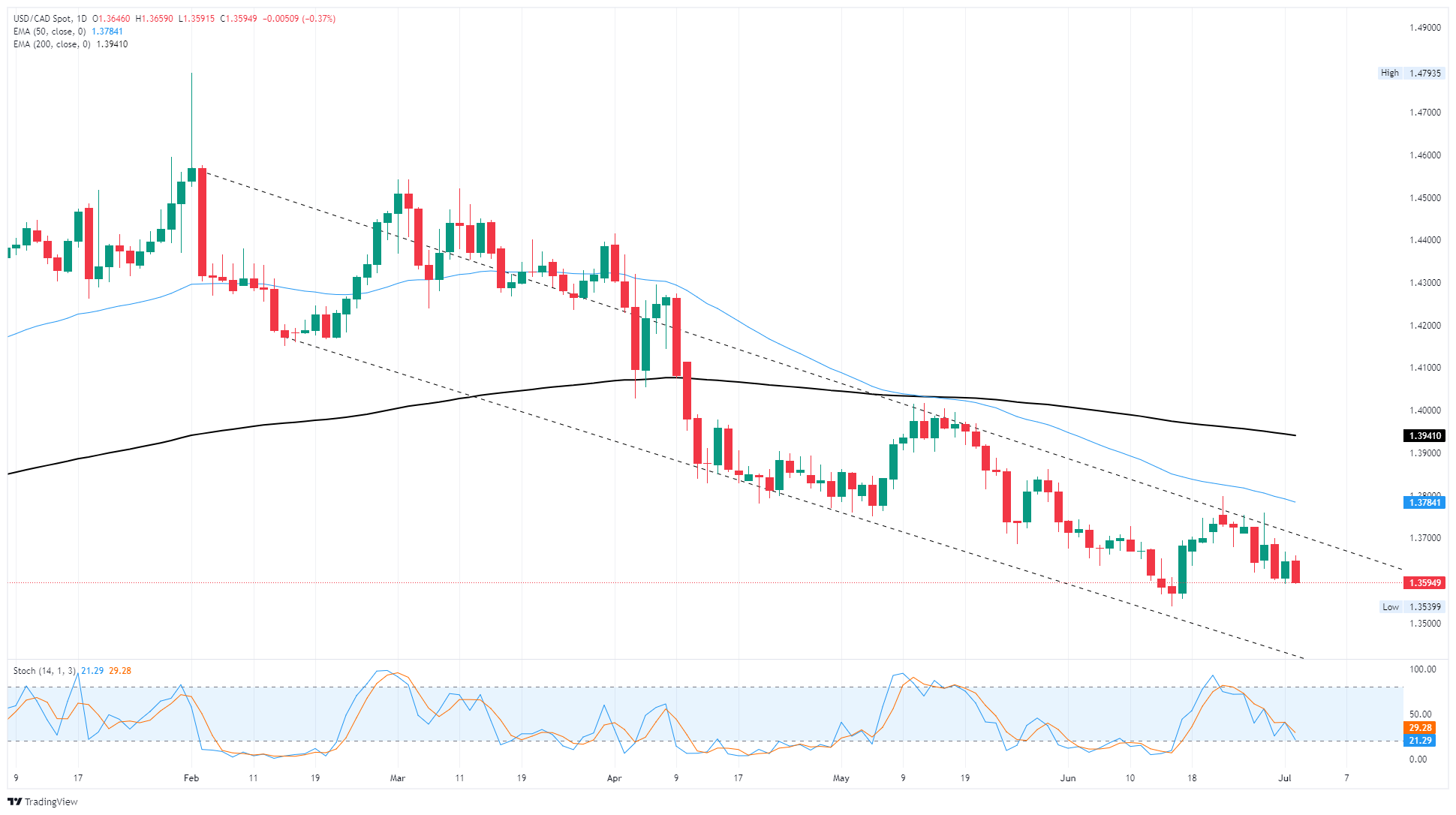Canadian Dollar continues upward grind as Greenback falters further
- The Canadian Dollar rose again on Wednesday, chopping away at Greenback positioning.
- A broad-market decline in US Dollar bidding has bolstered the Loonie back into the high end.
- Despite gains, the Canadian Dollar remains on precarious footing as Canadian economic data continues to soften.
The Canadian Dollar (CAD) rose on Wednesday, gaining another one-third of one percent as choppy downside Greenback momentum gives up further ground. Loonie gains are being cooked up entirely by USD selling pressure, putting CAD bulls in a tricky place and making swing plays a bumpy ride.
Canadian Manufacturing Purchasing Managers Index (PMI) figures backslid in June, falling to 45.6 as the Canadian economy continues to sputter in the face of an ongoing trade war with the US. Faltering Canadian economic data is making it difficult for the Bank of Canada (BoC) to jumpstart its rate-cutting cycle, a path that appears to be popular with BoC policymakers, even as further interest rate cuts begin to shake out Canadian bond yields and spark further rises in already-unaffordable housing prices via climbing mortgage rates.
Daily digest market movers: Canadian Dollar gets another step higher despite slumping PMI expectations
- The Canadian Dollar is back into a multi-week high, pushing the USD/CAD pair back down below 1.3600.
- Broad-market Greenback selling is giving the Loonie a boost.
- Canadian Manufacturing PMI figures came in on the low side for June as businesses continue to pull back into a defensive stance in the face of tumultuous trade issues with the US.
- US Nonfarm Payrolls (NFP) data looms large on Thursday, with Friday slated to be a thin showing. US markets will be shuttered for a holiday on Friday, functionally giving the market an early weekend.
- US ADP Employment Change figures came in sharply lower than forecasts, sparking fresh concerns of an economic slowdown looming over the US.
Canadian Dollar price forecast
Wednesday’s Loonie gains have put the Canadian Dollar one step closer to multi-year highs against the US Dollar, and the USD/CAD pair continues to drift into the low side as the Greenback circles the drain against the Loonie. Momentum is still firmly embedded in the CAD camp, with room to run still baked into technical oscillators. USD/CAD continues to follow a descending channel lower, and a technical floor could be priced into the charts near the 1.3500 region.
USD/CAD daily chart

Canadian Dollar FAQs
The key factors driving the Canadian Dollar (CAD) are the level of interest rates set by the Bank of Canada (BoC), the price of Oil, Canada’s largest export, the health of its economy, inflation and the Trade Balance, which is the difference between the value of Canada’s exports versus its imports. Other factors include market sentiment – whether investors are taking on more risky assets (risk-on) or seeking safe-havens (risk-off) – with risk-on being CAD-positive. As its largest trading partner, the health of the US economy is also a key factor influencing the Canadian Dollar.
The Bank of Canada (BoC) has a significant influence on the Canadian Dollar by setting the level of interest rates that banks can lend to one another. This influences the level of interest rates for everyone. The main goal of the BoC is to maintain inflation at 1-3% by adjusting interest rates up or down. Relatively higher interest rates tend to be positive for the CAD. The Bank of Canada can also use quantitative easing and tightening to influence credit conditions, with the former CAD-negative and the latter CAD-positive.
The price of Oil is a key factor impacting the value of the Canadian Dollar. Petroleum is Canada’s biggest export, so Oil price tends to have an immediate impact on the CAD value. Generally, if Oil price rises CAD also goes up, as aggregate demand for the currency increases. The opposite is the case if the price of Oil falls. Higher Oil prices also tend to result in a greater likelihood of a positive Trade Balance, which is also supportive of the CAD.
While inflation had always traditionally been thought of as a negative factor for a currency since it lowers the value of money, the opposite has actually been the case in modern times with the relaxation of cross-border capital controls. Higher inflation tends to lead central banks to put up interest rates which attracts more capital inflows from global investors seeking a lucrative place to keep their money. This increases demand for the local currency, which in Canada’s case is the Canadian Dollar.
Macroeconomic data releases gauge the health of the economy and can have an impact on the Canadian Dollar. Indicators such as GDP, Manufacturing and Services PMIs, employment, and consumer sentiment surveys can all influence the direction of the CAD. A strong economy is good for the Canadian Dollar. Not only does it attract more foreign investment but it may encourage the Bank of Canada to put up interest rates, leading to a stronger currency. If economic data is weak, however, the CAD is likely to fall.

